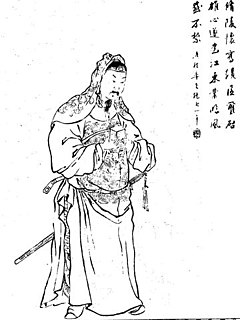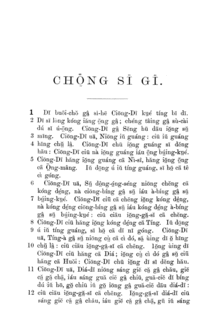
The hilt of a knife, dagger, sword, or bayonet is its handle, consisting of a guard, grip and pommel. The guard may contain a crossguard or quillons. A tassel or sword knot may be attached to the guard or pommel.

The jian is a double-edged straight sword used during the last 2,500 years in China. The first Chinese sources that mention the jian date to the 7th century BCE, during the Spring and Autumn period; one of the earliest specimens being the Sword of Goujian. Historical one-handed versions have blades varying from 45 to 80 centimeters in length. The weight of an average sword of 70-centimetre (28-inch) blade-length would be in a range of approximately 700 to 900 grams. There are also larger two-handed versions used for training by many styles of Chinese martial arts.

Dao are single-edged Chinese swords, primarily used for slashing and chopping. The most common form is also known as the Chinese sabre, although those with wider blades are sometimes referred to as Chinese broadswords. In China, the dao is considered one of the four traditional weapons, along with the gun, qiang (spear), and the jian, called in this group "The General of Weapons".

The Battle of Fei River, also known as the Battle of Feishui, was a battle in AD 383 in China, where forces of the Di-led Former Qin dynasty was decisively defeated by the outnumbered army of the Eastern Jin dynasty. The location of the battle, the Fei River, no longer exists, but is believed to have flowed through modern Lu'an, Anhui, near the Huai River. The battle is considered to be one of the most significant battles in the Chinese history. In the aftermath of the battle, the Former Qin fell into a massive civil war and resulted in its eventual collapse, ensuring the survival of the Eastern Jin and subsequent Han-ruled regimes south of the Yangtze River.

Sun Jian (155–191), courtesy name Wentai, was a Chinese military general, politician, and warlord who lived during the late Eastern Han dynasty of China. He allied himself with Yuan Shu in 190 when warlords from eastern China formed a coalition to oust Dong Zhuo, a tyrannical warlord who held the puppet Emperor Xian in his power. Although he controlled neither many troops nor much land, Sun Jian's personal bravery and resourcefulness were feared by Dong Zhuo, who placed him among Yuan Shao, Yuan Shu and Liu Biao as the most influential men at that time. After the coalition disbanded in the next year, China fell into massive civil war. In 191, Sun Jian was killed in battle during an offensive campaign against Liu Biao.

The English language terminology used in the classification of swords is imprecise and has varied widely over time. There is no historical dictionary for the universal names, classification or terminology of swords; A sword was simply a double edged knife.

The zhanmadao was a single-bladed anti-cavalry Chinese sword. It originated during the Han Dynasty and was especially common in Song China (960–1279).
Fu Jian, originally named Pu Jian, courtesy name Jianye (建業), formally Emperor Jingming of (Former) Qin ( 秦景明帝), was the founding emperor of the Di-led Chinese Former Qin dynasty.
Taijijian is a straight two-edged sword used in the training of the Chinese martial art Taijiquan. The straight sword, sometimes with a tassel and sometimes not, is used for upper body conditioning and martial training in traditional Taijiquan schools. The different family schools have various warmups, forms and fencing drills for training with the jian.

Beijing Bicycle is a 2001 Chinese drama film by Sixth Generation Chinese director Wang Xiaoshuai, with joint investment from the Taiwanese Arc Light Films and the French Pyramide Productions. The film stars first-time actors Cui Lin and Li Bin, supported by the already established actresses Zhou Xun and Gao Yuanyuan. It premiered at the Berlin International Film Festival on 17 February 2001 and won the Jury Grand Prix, but was subsequently banned in Mainland China. The ban was eventually lifted in 2004.
The Eighteen Arms is a list of the eighteen main weapons of Chinese martial arts. The origin of the list is unclear and there have been disputes as to what the eighteen weapons actually are. However, all lists contain at least one or more of the following weapons:

The liuyedao or willow-leaf saber is a type of dao that was commonly used as a military sidearm for both cavalry and infantry during the Ming and Qing dynasties. A descendant of the earlier Mongol saber the liuyedao remained the most popular type of single handed sabre during the Ming Dynasty, replacing the role of the Jian in the military. Many schools of Chinese martial arts originally trained with this weapon.

The Jian'ou dialect, also known as Kienow dialect, is a local dialect of Northern Min Chinese spoken in Jian'ou in northern Fujian province. It is regarded as the standard common language in Jian'ou.
Historically, all Chinese swords are classified into two types, jian and dao. Jians are double-edged straight swords while daos are single-edged, and mostly curved from the Song dynasty forward. The jian has been translated at times as a long sword, and the dao a saber or a knife. Bronze jians appeared during the Western Zhou period and switched to wrought iron and steel during the late Warring States period. In modern times, the ceremonial commissioned officer's sword of the Chinese navy has been patterned after the traditional jian since 2008.
Jian Fang Lay-Hong, is a right-handed Chinese-born Australian ladies table tennis player. She plays penhold, with a long pimple rubber at one side for use of attacking, blocking as well as chopping. She is currently number 1 female player in Australia, as well as number 141 in the world. At the 2020 Tokyo Olympics she became the first Australian woman to compete at 6 Olympic games.

Jian is a village in Beyza Rural District, Beyza District, Sepidan County, Fars Province, Iran. At the 2006 census, its population was 2,107, in 444 families.

Huangshanlong is a genus of mamenchisaurid dinosaurs native to the Anhui province of China. It contains a single species, Huangshanlong anhuiensis. H. anhuiensis represents, along with Anhuilong and Wannanosaurus, one of three dinosaurs fround in Anhui province.
Zuoyunlong is an extinct genus of herbivorous ornithischian dinosaur belonging to the Hadrosauroidea, that lived during the Late Cretaceous in the area of present China.
Jinbeisaurus is a genus of tyrannosauroid dinosaur from the Upper Cretaceous Huiquanpu Formation from Shanxi Province in China. The type and only species is Jinbeisaurus wangi. It is the first non-avian theropod known from Shanxi. Analysis of the specimen indicates that Jinbeisaurus is more derived than related tyrannosauroids such as Xiongguanlong and phylogenetically more advanced than Suskityrannus, to which it has been compared.
Tàizǔquán is a style of Chinese martial arts whose name refers to Emperor Tàizǔ of Sòng, the founder of the Sòng dynasty.












